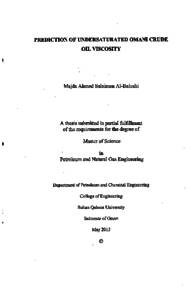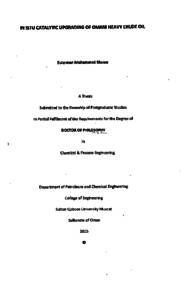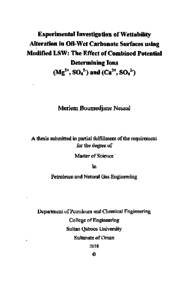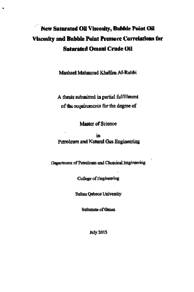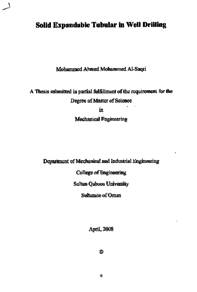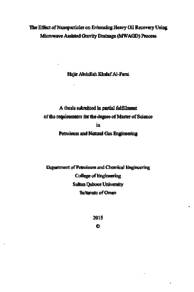وثيقة
Prediction of undersaturated Omani crude oil viscosity
الناشر
Sultan Qaboos University
ميلادي
2013
اللغة
الأنجليزية
الملخص الإنجليزي
Numerical correlations are widely used in the petroleum industry in order to predict crude oil viscosity at different pressures (above, below and at bubble point pressure) and bubble point pressure. These correlations often use field-measured variables. This study is mainly conducted to develop a new correlation for predicting the viscosity of the undersaturated Omani crude oil with field-measured data due to its importance in oil industry since it represents the viscosity at the initial stage for reservoirs above the bubble point pressure. In addition, the correlations for bubble point oil viscosity and bubble point pressure are also established in this study based on measured data for Omani crude oil which can be used to predict undersaturated oil viscosity in case these data were not available.
The first step in this study was creating a large database from 118 pressure-volume temperature (PVT) reports and screening them to remove all unreliable data. Then the available correlations in the literature for predicting undersaturated crude oil viscosity, bubble point oil viscosity and bubble point pressure were evaluated for Omani crude oil. Since most of the available undersaturated oil viscosity correlations provided good predictions for Omani crude oil viscosity, therefore those correlations were modified for Omani crude oil to reduce the error further so that they can better predict the undersaturated oil viscosity. Then a new correlation was developed for undersaturated Omani crude oil viscosity with field-measured data using an optimization routine based on the Genetic Algorithm (GA) method in Matlab with an average absolute relative error (AARE) of 4.12%. Two new correlations were developed for bubble point oil viscosity for different ranges of stock tank oil API gravity with an AARE of 14.06% for the complete range of data. In addition, a new correlation was developed for the bubble point pressure with an AARE value of 11.16%.
Finally, the accuracy of the predicted correlations was validated against the available ones. The validation tests showed that the performance of the proposed correlation for undersaturated oil viscosity is better than the best three published correlations and equivalent to the best three modified ones with field-measured data having an AARE value of 3.96%. In addition, the proposed correlations for bubble point oil viscosity and bubble point pressure were found to outperform the available ones with an AARE of 14.98% and 14.30% respectively. Moreover, it was indicated that using different correlations for bubble point oil viscosity predicted for different ranges of stock tank oil API gravity improves the performance of all available correlations for undersaturated oil viscosity. This is due to the fact that oil density is a fundamental characteristic on which different oil properties depend on. Oils with different API values will have different properties. Therefore, different correlations for different ranges of API are more representative for predicting oils physical properties. On the other hand, calculated bubble point pressure does not show noticeable effect on the performance of the undersaturated oil viscosity. This can be explained by the high degree of randomness in pressure differential values with respect to oil viscosity which cannot be explained by the model.
المجموعة
URL المصدر
الملخص العربي
تستخدم العلاقات العددية على نطاق واسع في مجال الصناعات النفطية لأجل التنبؤ بلزوجة النفط الخام عند ضغوط مختلفه (عند أو أعلى أو أقل من ضغط نقطة الفقاعة) كما انها تستخدم للتنبؤ بالضغط عند نقطة الفقاعة. وهذه العلاقات غالبا ما تستخدم المتغيرات التي يتم حسابها من البيانات الحقلية. لذلك تم إجراء هذه الدراسة أساسا لإيجاد علاقة جديدة للتنب بلزوجة النفط الخام العماني الغير المشبع وذلك لأنه يمثل اللزوجة الإبتدائية للنفط في المكامن التي تكون على ضغط أعلى من نقطة الفقاعة. بالإضافة إلى ذلك تم وضع المعادلات التي تستخدم للتنبؤ باللزوجة عند ضغط نقطة الفقاعة ومعادلة ضغط نقطة الفقاعة والتي يمكن استخدامها للتنبؤ بلزوجة النفط الغير المشبع في حالة عدم توافر هذه البيانات.
المرحلة الأولى من هذه الدراسة تمثلت بخلق قاعدة بيانات من 118 تقرير مخبري خاص بالضغط. الحجم. لرجة الحرارة (PVT) والتحقق من صحتها لإزالة كافة البيانات الغير موثوق فيها. تبع ذلك تقييم المعادلات المتوفرة في المؤلفات السابقة للتنبؤ بلزوجة النفط الغير المشبع واللزوجة عند ضغط نقطة الفقاعة وضغط نقطة الفقاعة . لوحظ من نتائج التقييم بأن معظم المعادلات المتوفرة تقدم نسبة جيدة للتنبؤ بلزوجة النفط العماني الغير المشبع لذلك تم تعديل هذه المعادلات باستخدام بيانات النفط الخام العماني لتقليل الخطأ بنسبة أكبر، ثم تم ايجاد علاقة جديدة باستخدام الخوارزمية الوراثية (Genetic Algorithm) بمتوسط خطا نسبي مطلق % 4 . 12. بعد ذلك تم ايجاد علاقتين جديدتين للزوجة النفط عند ضغط نقطة الفقاعة لكثافات النفط المختلفة بمتوسط خطا نسبی مطلق للمعادلتين على كافة البيانات بمقدار % 14 . 06 . كما تم ايجاد علاقة جديدة لضغط نقطة الفقاعة بمتوسط خطا نسبي مطلق يساوي 11.16% وأخيرا تم التحقق من دقة تلك المعادلات مقارنة بتلك المتاحة أختبارات التحقق أظهرت أن العلاقة المقترحة في هذه الدراسة لمعرفة لزوجة النفط الغير المشبع تتماثل في أدائها مع أفضل ثلاث معادلات ضمن تلك التي تم تعديلها. كما انها أثبتت أفضلية المعادلة المقترحة في هذه الدراسة على تلك المتوفرة في المؤلفات السابقة وقيمة متوسط الخطا النسبي المطلق للمعادلة التي تم ايجادها في هذه الدراسة تساوي % 3 . 96. اختبار دقة المعادلات التي تم اقتراحها لمعرفة اللزوجة عند ضغط نقطة الفقاعة ومعادلة ضغط نقطة الفقاعة أثبتت أفضلية هذه المعادلات عن المعادلات المتوفرة من الدراسات السابقة بمتوسط الخطا النسبي المطلق % 14 . 98 و% 14
. 30 على التوالي. بالإضافة إلى ذلك تم إثبات أن استخدام معادلتين مختلفتين لمعرفة لزوجة النفط عند ضغط نقطة الفقاعة تحسن من أداء كل المعادلات المتاحة لمعرفة لزوجة النفط الغير المتشيع، وهذا قد يرجع للحقيقة بان كثافة النفط تحدد خواص النفط الخام واستخدام معادلات مختلفة لكثافات مختلفة قد تؤدي إلى نتائج أفضل لمعرفة خواص النفط في حين معادلة الضغط عند نقطة الفقاعة لا تظهر تأثير واضح على أداء معادلات اللزوجة للنفط الغير المشبع، ويمكن تفسير ذلك من خلال الحرجة العالية من العشوائية في العلاقة بين قيم الفرق في الضغط مع الزوجة النفط وهذا لا يمكن تفسيره في هذا النموذج
المرحلة الأولى من هذه الدراسة تمثلت بخلق قاعدة بيانات من 118 تقرير مخبري خاص بالضغط. الحجم. لرجة الحرارة (PVT) والتحقق من صحتها لإزالة كافة البيانات الغير موثوق فيها. تبع ذلك تقييم المعادلات المتوفرة في المؤلفات السابقة للتنبؤ بلزوجة النفط الغير المشبع واللزوجة عند ضغط نقطة الفقاعة وضغط نقطة الفقاعة . لوحظ من نتائج التقييم بأن معظم المعادلات المتوفرة تقدم نسبة جيدة للتنبؤ بلزوجة النفط العماني الغير المشبع لذلك تم تعديل هذه المعادلات باستخدام بيانات النفط الخام العماني لتقليل الخطأ بنسبة أكبر، ثم تم ايجاد علاقة جديدة باستخدام الخوارزمية الوراثية (Genetic Algorithm) بمتوسط خطا نسبي مطلق % 4 . 12. بعد ذلك تم ايجاد علاقتين جديدتين للزوجة النفط عند ضغط نقطة الفقاعة لكثافات النفط المختلفة بمتوسط خطا نسبی مطلق للمعادلتين على كافة البيانات بمقدار % 14 . 06 . كما تم ايجاد علاقة جديدة لضغط نقطة الفقاعة بمتوسط خطا نسبي مطلق يساوي 11.16% وأخيرا تم التحقق من دقة تلك المعادلات مقارنة بتلك المتاحة أختبارات التحقق أظهرت أن العلاقة المقترحة في هذه الدراسة لمعرفة لزوجة النفط الغير المشبع تتماثل في أدائها مع أفضل ثلاث معادلات ضمن تلك التي تم تعديلها. كما انها أثبتت أفضلية المعادلة المقترحة في هذه الدراسة على تلك المتوفرة في المؤلفات السابقة وقيمة متوسط الخطا النسبي المطلق للمعادلة التي تم ايجادها في هذه الدراسة تساوي % 3 . 96. اختبار دقة المعادلات التي تم اقتراحها لمعرفة اللزوجة عند ضغط نقطة الفقاعة ومعادلة ضغط نقطة الفقاعة أثبتت أفضلية هذه المعادلات عن المعادلات المتوفرة من الدراسات السابقة بمتوسط الخطا النسبي المطلق % 14 . 98 و% 14
. 30 على التوالي. بالإضافة إلى ذلك تم إثبات أن استخدام معادلتين مختلفتين لمعرفة لزوجة النفط عند ضغط نقطة الفقاعة تحسن من أداء كل المعادلات المتاحة لمعرفة لزوجة النفط الغير المتشيع، وهذا قد يرجع للحقيقة بان كثافة النفط تحدد خواص النفط الخام واستخدام معادلات مختلفة لكثافات مختلفة قد تؤدي إلى نتائج أفضل لمعرفة خواص النفط في حين معادلة الضغط عند نقطة الفقاعة لا تظهر تأثير واضح على أداء معادلات اللزوجة للنفط الغير المشبع، ويمكن تفسير ذلك من خلال الحرجة العالية من العشوائية في العلاقة بين قيم الفرق في الضغط مع الزوجة النفط وهذا لا يمكن تفسيره في هذا النموذج
قالب العنصر
الرسائل والأطروحات الجامعية

